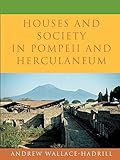Houses and Society in Pompeii and Herculaneum / Andrew Wallace-Hadrill.
Material type: TextPublisher: Princeton, NJ : Princeton University Press, [2022]Copyright date: ©1994Description: 1 online resource (272 p.) : 8 color plates 122 figs. 6 tablesContent type:
TextPublisher: Princeton, NJ : Princeton University Press, [2022]Copyright date: ©1994Description: 1 online resource (272 p.) : 8 color plates 122 figs. 6 tablesContent type: - 9780691244150
- ARCHITECTURE / History / General
- Abdication
- Aedicula
- Alleius Nigidius Maius
- Allusion
- Ancillae
- Antechamber
- Apartment
- Archetype
- Architectural plan
- Aristocracy
- Art group
- Author
- Biography
- Building
- Cabinetry
- City-state
- Civil society
- Clothing
- Commius
- Consideration
- Contemporary society
- Count
- Credential
- Cultural capital
- Cultural history
- Designer
- Dowry
- Dwelling
- Dynasty
- Economy
- Edward Gorey
- Ephesus
- Etiquette
- Exedra
- Extended family
- Floriculture
- Freedman
- Herculaneum
- House plan
- House
- Household
- Housing
- Infrastructure
- Insula (building)
- Interior design
- Legatee
- Literature
- Living Space
- Lodging
- Magnificence (history of ideas)
- Mattress
- Nobility
- Occupancy
- Opus sectile
- Osteria
- Ostia (Rome)
- Ownership
- Parlour
- Pergamon
- Periodical literature
- Peristyle
- Pinacotheca
- Political economy
- Pompeii
- Population density
- Portico
- Poster
- Preservationist
- Promiscuity
- Pronoun
- Proportion (architecture)
- Publication
- Quartile
- Residence
- Residential area
- Ruler
- Show house
- Social class
- Social integration
- Social position
- Social relation
- Social science
- Social status
- Society
- Sociology
- Studio apartment
- Taberna
- Tablinum
- Tacitus
- Tenement
- Tibullus
- Triclinium
- Trimalchio
- Ulpian
- Usage
- Vault (architecture)
- Vestibule (architecture)
- Vitruvius
- Wallpaper
- Workforce
- 307.3/3616/09377
- online - DeGruyter
| Item type | Current library | Call number | URL | Status | Notes | Barcode | |
|---|---|---|---|---|---|---|---|
 eBook
eBook
|
Biblioteca "Angelicum" Pont. Univ. S.Tommaso d'Aquino Nuvola online | online - DeGruyter (Browse shelf(Opens below)) | Online access | Not for loan (Accesso limitato) | Accesso per gli utenti autorizzati / Access for authorized users | (dgr)9780691244150 |
Browsing Biblioteca "Angelicum" Pont. Univ. S.Tommaso d'Aquino shelves, Shelving location: Nuvola online Close shelf browser (Hides shelf browser)

|

|

|

|

|

|

|
||
| online - DeGruyter Japan and Its World : Two Centuries of Change / | online - DeGruyter The Novel, Volume 2 : Forms and Themes / | online - DeGruyter The Novel, Volume 1 : History, Geography, and Culture / | online - DeGruyter Houses and Society in Pompeii and Herculaneum / | online - DeGruyter Face and Mask : A Double History / | online - DeGruyter Marketing Maximilian : The Visual Ideology of a Holy Roman Emperor / | online - DeGruyter Visuality and Virtuality : Images and Pictures from Prehistory to Perspective / |
Frontmatter -- CONTENTS -- LIST OF PLATES -- LIST OF FIGURES AND TABLES -- PREFACE -- NOTE ON FORM OF REFERENCES TO HOUSES -- PART I. THE SOCIAL STRUCTURE OF THE ROMAN HOUSE -- CHAPTER 1. Reading the Roman House -- CHAPTER 2. The Language of Public and Private -- CHAPTER 3. The Articulation of the House -- PART II. SAMPLING POMPEII AND HERCULANEUM -- CHAPTER 4. Houses and Urban Texture -- CHAPTER 5. Houses and Households -- CHAPTER 6. Houses and Trade -- CHAPTER 7. Luxury and Status -- CHAPTER 8. Epilogue -- APPENDIX: LIST OF HOUSES SURVEYED -- NOTES -- GLOSSARY -- BIBLIOGRAPHY -- INDEX
restricted access online access with authorization star
http://purl.org/coar/access_right/c_16ec
Few sources reveal the life of the ancient Romans as vividly as do the houses preserved by the eruption of Vesuvius. Wealthy Romans lavished resources on shaping their surroundings to impress their crowds of visitors. The fashions they set were taken up and imitated by ordinary citizens. In this illustrated book, Andrew Wallace-Hadrill explores the rich potential of the houses of Pompeii and Herculaneum to offer new insights into Roman social life. Exposing misconceptions derived from contemporary culture, he shows the close interconnection of spheres we take as discrete: public and private, family and outsiders, work and leisure. Combining archaeological evidence with Roman texts and comparative material from other cultures, Wallace-Hadrill raises a range of new questions. How did the organization of space and the use of decoration help to structure social encounters between owner and visitor, man and woman, master and slave? What sort of "households" did the inhabitants of the Roman house form? How did the world of work relate to that of entertainment and leisure? How widely did the luxuries of the rich spread among the houses of craftsmen and shopkeepers? Through analysis of the remains of over two hundred houses, Wallace-Hadrill reveals the remarkably dynamic social environment of early imperial Italy, and the vital part that houses came to play in defining what it meant "to live as a Roman."
Mode of access: Internet via World Wide Web.
In English.
Description based on online resource; title from PDF title page (publisher's Web site, viewed 29. Jun 2022)


